|
||||||||||||||||||||||
![Home - Air Power Australia Website [Click for more ...]](APA/APA-Title-NOTAM.png) |
||||||||||||||||||||||
![Sukhoi PAK-FA and Flanker Index Page [Click for more ...]](APA/flanker.png) |
![F-35 Joint Strike Fighter Index Page [Click for more ...]](APA/jsf.png) |
![Weapons Technology Index Page [Click for more ...]](APA/weps.png) |
![News and Media Related Material Index Page [Click for more ...]](APA/media.png) |
|||||||||||||||||||
![Surface to Air Missile Systems / Integrated Air Defence Systems Index Page [Click for more ...]](APA/sams-iads.png) |
![Ballistic Missiles and Missile Defence Page [Click for more ...]](APA/msls-bmd.png) |
![Air Power and National Military Strategy Index Page [Click for more ...]](APA/strategy.png) |
![Military Aviation Historical Topics Index Page [Click for more ...]](APA/history.png)
|
![Intelligence, Surveillance and Reconnaissance and Network Centric Warfare Index Page [Click for more ...]](APA/isr-ncw.png) |
![Information Warfare / Operations and Electronic Warfare Index Page [Click for more ...]](APA/iw.png) |
![Systems and Basic Technology Index Page [Click for more ...]](APA/technology.png) |
![Related Links Index Page [Click for more ...]](APA/links.png) |
|||||||||||||||
![Homepage of Australia's First Online Journal Covering Air Power Issues (ISSN 1832-2433) [Click for more ...]](APA/apa-analyses.png) |
|
|||||||||||||||||||||
| Last Updated: Mon Jan 27 11:18:09 UTC 2014 | ||||||||||||||||||||||
|
||||||||||||||||||||||
|
||||||||||||||||||||||
![Home - Air Power Australia Website [Click for more ...]](APA/APA-Title-NOTAM.png) |
||||||||||||||||||||||
![Sukhoi PAK-FA and Flanker Index Page [Click for more ...]](APA/flanker.png) |
![F-35 Joint Strike Fighter Index Page [Click for more ...]](APA/jsf.png) |
![Weapons Technology Index Page [Click for more ...]](APA/weps.png) |
![News and Media Related Material Index Page [Click for more ...]](APA/media.png) |
|||||||||||||||||||
![Surface to Air Missile Systems / Integrated Air Defence Systems Index Page [Click for more ...]](APA/sams-iads.png) |
![Ballistic Missiles and Missile Defence Page [Click for more ...]](APA/msls-bmd.png) |
![Air Power and National Military Strategy Index Page [Click for more ...]](APA/strategy.png) |
![Military Aviation Historical Topics Index Page [Click for more ...]](APA/history.png)
|
![Intelligence, Surveillance and Reconnaissance and Network Centric Warfare Index Page [Click for more ...]](APA/isr-ncw.png) |
![Information Warfare / Operations and Electronic Warfare Index Page [Click for more ...]](APA/iw.png) |
![Systems and Basic Technology Index Page [Click for more ...]](APA/technology.png) |
![Related Links Index Page [Click for more ...]](APA/links.png) |
|||||||||||||||
![Homepage of Australia's First Online Journal Covering Air Power Issues (ISSN 1832-2433) [Click for more ...]](APA/apa-analyses.png) |
|
|||||||||||||||||||||
| Last Updated: Mon Jan 27 11:18:09 UTC 2014 | ||||||||||||||||||||||
|
||||||||||||||||||||||
J-20
Stealth
Fighter: China's First Strike Weapon
|
|||||||||||||||||||||||||||||||||||||||||||||||||||||||||||||||||||||||||||||||||||||||||||||||||||||||||||||||||||||||||||||||||||||||||||||||||||||||||||||||||||||||||||||||||||||||||||||
|
Air Power
Australia - Australia's Independent Defence Think Tank
|
|||||||||||||||||||||||||||||||||||||||||||||||||||||||||||||||||||||||||||||||||||||||||||||||||||||||||||||||||||||||||||||||||||||||||||||||||||||||||||||||||||||||||||||||||||||||||||||
| Air Power Australia NOTAM 24th January, 2011 © 2011 C. L. Mills |
|||||||||||||||||||||||||||||||||||||||||||||||||||||||||||||||||||||||||||||||||||||||||||||||||||||||||||||||||||||||||||||||||||||||||||||||||||||||||||||||||||||||||||||||||||||||||||||
|
|||||||||||||||||||||||||||||||||||||||||||||||||||||||||||||||||||||||||||||||||||||||||||||||||||||||||||||||||||||||||||||||||||||||||||||||||||||||||||||||||||||||||||||||||||||||||||||
|
|||||||||||||||||||||||||||||||||||||||||||||||||||||||||||||||||||||||||||||||||||||||||||||||||||||||||||||||||||||||||||||||||||||||||||||||||||||||||||||||||||||||||||||||||||||||||||||
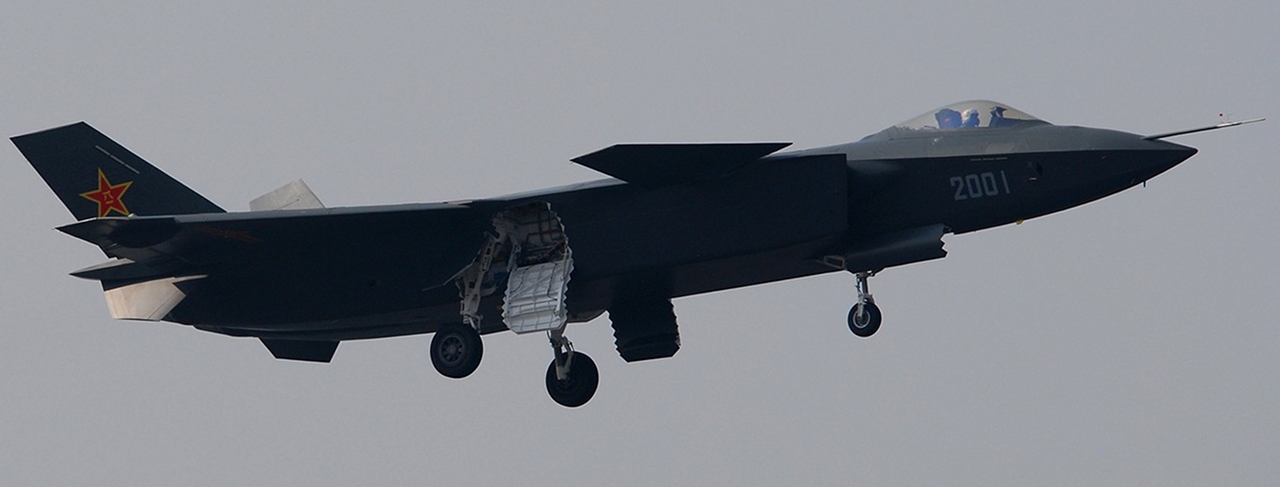 First prototype of the Chengdu J-XX or J-20 Very
Low Observable (VLO) fighter aircraft. A large high performance design
with
excellent stealth shaping, this aircraft is expected to be become the
centrepiece of the PLA-AF fighter fleet. It combines the innovative
harmonisation of extreme plus agility, supersonic cruise, large range
and persistence, and stealth, achieved through the rigorous and
disciplined application of Chinese interpretations of western
engineering design rules and the advanced manufacturing and production
technologies in which China now leads the world
(Chinese Internet).
|
|||||||||||||||||||||||||||||||||||||||||||||||||||||||||||||||||||||||||||||||||||||||||||||||||||||||||||||||||||||||||||||||||||||||||||||||||||||||||||||||||||||||||||||||||||||||||||||
 |
|||||||||||||||||||||||||||||||||||||||||||||||||||||||||||||||||||||||||||||||||||||||||||||||||||||||||||||||||||||||||||||||||||||||||||||||||||||||||||||||||||||||||||||||||||||||||||||
|
|||||||||||||||||||||||||||||||||||||||||||||||||||||||||||||||||||||||||||||||||||||||||||||||||||||||||||||||||||||||||||||||||||||||||||||||||||||||||||||||||||||||||||||||||||||||||||||
|
The
Chairman of the Central Military Commission of the People’s
Republic of China looked at the Committee members, assembled in the
August 1st
Building, at the dawn of 6 December 2020.
The air was charged with tension and expectation. “Tomorrow, if you each tell me your plans and Forces are ready, we will immediately end the US hegemony of the Western Pacific. The US, despite our repeated warnings, has continued to arm the rebel Government in Taiwan, the latest shipments being 200 F-35s they had surplus after JSF sales to Europe collapsed. These aircraft are now in action against us, and in the past week, three J-10A ‘Vigorous Dragon’ fighters have been destroyed while on peaceful patrols of the Straights. This behaviour cannot, and will not be tolerated. Now, let me ask about your preparedness – and true and accurate reports only – if there are weaknesses, now is the time to correct them, not in the heat of battle. Commander-in-Chief (CIC), tell us the strategic plan.” The CIC rises and opens a PowerPoint briefing on a large screen. “Our military forces will eliminate the larger US bases across the Western Pacific. Each of the Armed Services will have a substantial role on this Joint and highly coordinated operation. The Second Artillery using DF-21 terminally guided IRBMs; the PLA-AF using the new J-20 ‘Black Eagle’ stealth fighters; and, the PLA-N will employ submarine launched cruise missiles, mainly our excellent DH-10 missiles. Our Intelligence Agencies have been collecting targeting information on critical infrastructure for several years. The initial targets will be digital communications and military installations and equipment. If US naval forces come within 1,000 nautical miles of our coast, they will be attacked with terminally guided DF-21D missiles. Each of our designated Fire Bases will be protected by mobile Surface to Air Missile batteries. Any incoming counter-attack will be detected at long range by HF Sky-Wave and Surface-Wave Over-The-Horizon-radars. Preparations will take place in our “super-hardened” underground airbase hangars to avoid observation by US spy satellites. We have other assets prepared. Mr Chairman, here is the Military Tasking Order of Operation Long March’ …” There is a sharp intake of breath as the PowerPoint slide is flashed onto the screen. The scope and scale of Operation Long March makes the infamous 1941 Pearl Harbour attack look like a mere tactical skirmish. |
|||||||||||||||||||||||||||||||||||||||||||||||||||||||||||||||||||||||||||||||||||||||||||||||||||||||||||||||||||||||||||||||||||||||||||||||||||||||||||||||||||||||||||||||||||||||||||||
|
|||||||||||||||||||||||||||||||||||||||||||||||||||||||||||||||||||||||||||||||||||||||||||||||||||||||||||||||||||||||||||||||||||||||||||||||||||||||||||||||||||||||||||||||||||||||||||||
|
The
members study the PowerPoint table in complete silence. Each of the
Service Chiefs’ heads nod in agreement, knowing that the deployment
of forces is well within their operational capabilities and the
skills of their crews.
“A question – why Guam International?” says the Chairman. “We know that some military aircraft are parked in the hangars to the north of the airfield, but our main target is the fibre-optic hubs near the airport. When we breach those, much of the digital communication across the Pacific to the US will be terminated. This will force the American military and their allies to have to use very limited bandwidth satellites – and we can knock those down too, if we wish” is the reply from CIC. “Thank you Commander-in-Chief, a good answer. Minister for Finance?” invites the Chairman. The Minister stands and moves to the Podium. He speaks quietly and confidently, and the members strain to hear him. “Our finances are ready to weather the disruption this action may bring. Our GDP is now larger than the whole of the American GDP. We have reduced our exposure in US Treasury holdings to less than $US15B – the Americans’ program of printing money has made them virtually worthless as the US dollar continues to decline in value. We have moved our trillions of FOREX USD into the currencies of our trading partners, raising the value of their currency relative to ours so they can afford to buy our goods, and of course making their futures dependent on our holdings. Our gold reserves are over 2,000 tonnes. We plan to sell a large amount when the action starts, while keeping our other precious metal holdings in reserve. We expect the profit will easily offset the cost of Operation Long March. We are in good shape.” Next, the Chief of the PLA speaks. “Our DF-21 forces are in position. We plan to launch 30 to 60 rounds into each target.” “Won’t that be expensive?” asks the Minister for Finance? “No”, replies the Minister for Defence Materiel, “these missiles are nearly time-expired. It costs as much to refurbish them as to build the new and more effective DF-21Ds.” “Just so” says the PLA Chief, “We have upgraded the guidance system to the ‘C’ model, so they will be very accurate and cost-effective.” As if an afterthought, he says, “I also have the HQ-9, the S-300PMU2, S-400 and the HQ-20 SAMs in place to protect the launch Firebases and the key cities of the Homeland if the USA decides to launch cruise missiles from bombers or submarines. We will not get them all, but we will get most and protect our cities and people.” “Air Force?” asks the Chairman. “We have been receiving one J-20 stealth fighter a week since 2016,” the PLA Chief continues, “We now have 160 J-20A single-seat fighters, and 80 J-20B two-seat theatre-bombers. These are all in fully operational service, so the MTO just fits. You know, the US Secretary of Defence Robert Gates was half right when he said China would not have a ‘Stealth Fighter’ until 2025 – perhaps he was speaking of our mature and full capability. But I digress. With the low signature of the J-20, we can employ our excellent satellite guided glide bombs, and the Minister for Finance might be pleased to hear that our estimate of the ordnance cost for an airfield target will be less than $US4 million. Not a bad economic exchange for the destruction of American military capabilities.” “And the Navy?” invites the Chairman. “We have our submarines in place near each target, and they will be in deep water as they fire, so have an excellent chance of escaping,” he advises. “This attack will not destroy these bases, but there will be a lot of damage and loss of capability, especially aircraft the Americans arrogantly park on open tarmacs. I also have underwater assets in place off Los Angeles, and there are several ships carrying containerised Klub cruise missiles off the East and West Coast of the USA, if we need any follow-up action.” “Thank you all. Now, what of the 200 F-35s on Taiwan?” asks the Chairman. The Minister for Cyber Defense, Madam Chien-Shiung Wu, has a Berkeley PhD in Computer Science and is young, brilliant and beautiful – in a scintillating pink-diamond sort of way, and speaks with chilling certainty. “Over the past decade, my staff have penetrated the JSF software facilities and have made ‘certain changes’ that cripple the JSF. This is classified ‘above top secret’ and so you do not need to know more”. The Air Force Chief asks “Then how were my three J-10A’s destroyed by the Taiwanese F-35s?” “A piece of deceptive illusion,” replies Madame Wu, “We had to convince the US with a war-like demonstration that their F-35’s systems work, so we ‘arranged’ a successful F-35 attack on the J-10s - when you are network dependent you are cyber-vulnerable. Our pilots were specially briefed and ejected in straight and level flight just before the Taiwanese AIM-120 missiles hit. So the arrogant Americans will think their ‘war-tested’ F-35s are working perfectly.” “Well, even if they have found this bug,” advises the Army Chief, “we have been using the F-35 operations over Taiwan to check its signatures, and my SAM people say even the obsolete HQ-9s will kill them. I also have the HQ-20s ready.” “And I have J-10As and Bs and our J-11Bs on alert ready to catch any you don’t get,” says the Air Force Chief with equally chilling confidence. “Are you all confident that ‘Operation Long March’ will be successful?” asks the Chairman. All heads nod in agreement. “Very well, the attack on Andersen Air Force Base will start at 10:00AM Local Time on 7 December 2020. The submarine and DF-21 attacks will be delayed accordingly, as advised by CIC, to provide the Black Eagles with the advantage of complete surprise.” The Chief of the Air Force General Yónggàn de Zhànshì rises and asks the Chairman, “My son is the J-20B Wing Commander. I am fully qualified on the J-20B. May I fly into battle as one of my son’s wingmen?” “General, you may”, agrees the Chairman, “and our good fortune flies with you.” |
|||||||||||||||||||||||||||||||||||||||||||||||||||||||||||||||||||||||||||||||||||||||||||||||||||||||||||||||||||||||||||||||||||||||||||||||||||||||||||||||||||||||||||||||||||||||||||||
 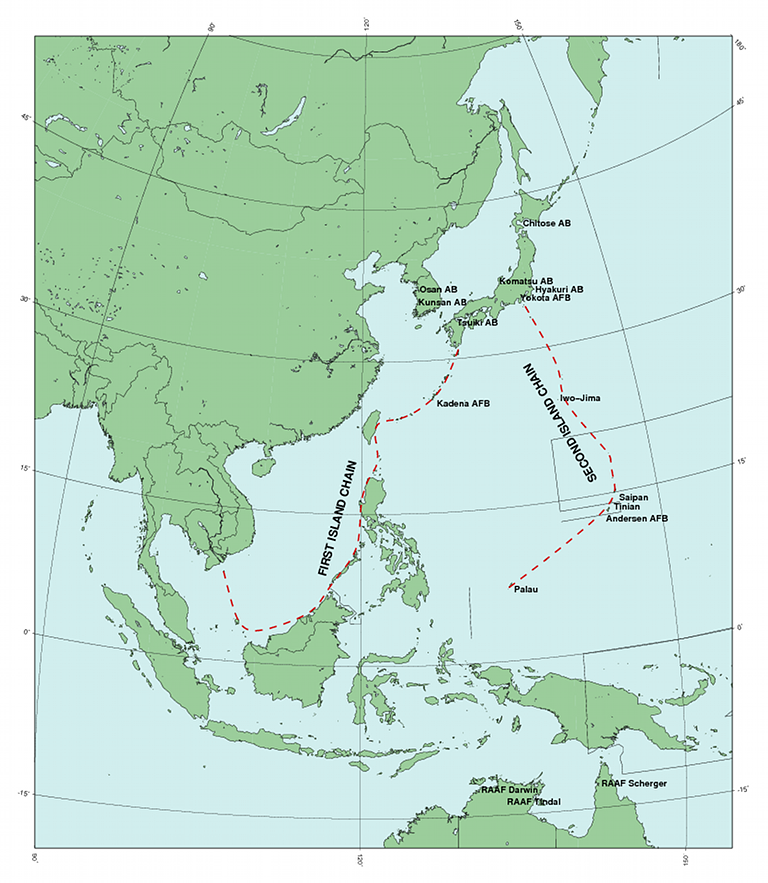 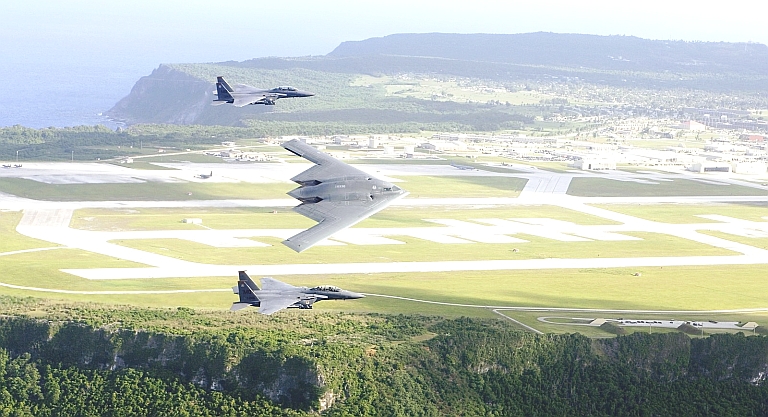 Andersen
AFB at Guam. The absence of modern hardening measures presents a major
survivability challenge for this base in any escalated contingency (US
Air
Force image).
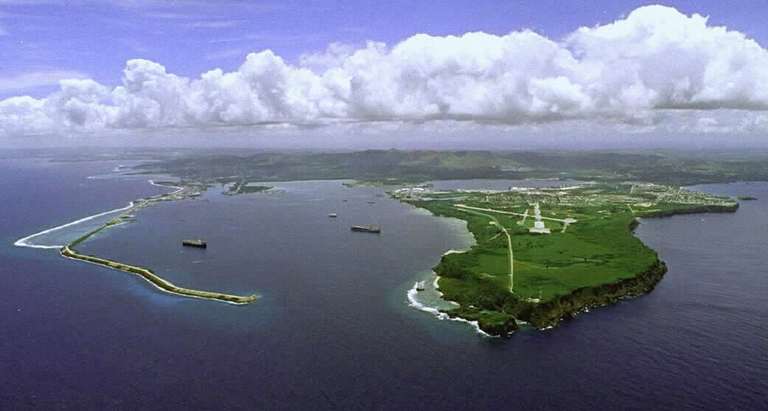 Apra Harbour Naval
Complex on Guam (US DoD).
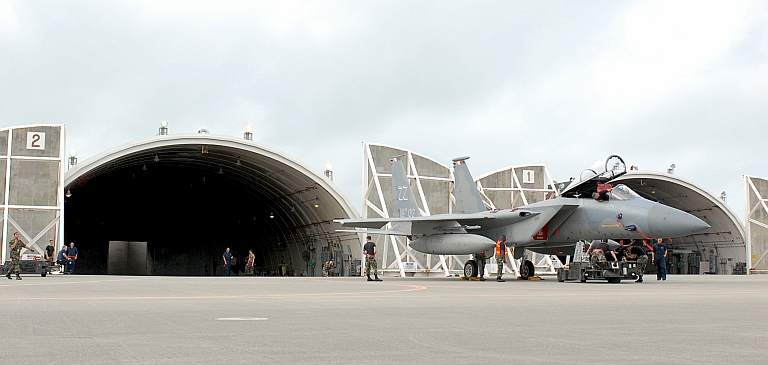 Kadena
AFB,
Okinawa,
home
of
the
18th
Wing. In the background are TAB-V Hardened Aircraft
Shelters, which are not designed to survive hits from bunker buster
penetrating munitions (US Air
Force image).
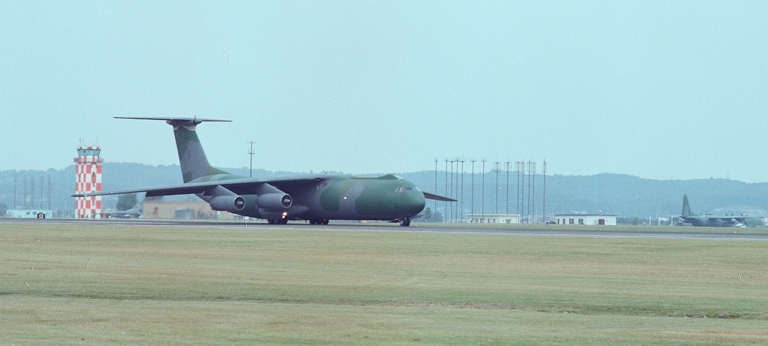 C-141B
Starlifter
of
the
63rd
MAW,
Norton
AFB, taxiing at Yokota AFB in the
outer western Tokyo suburbs, a major logistical hub and HQ site for the
5th Air Force. Yokota AFB is an unhardened air base (© 1984 - 2010
C. Kopp).
CV-41
USS
Midway
and
CV-62
USS Independence berthed at Yokosuka, south of Yokohama, in
1991 (US DoD).
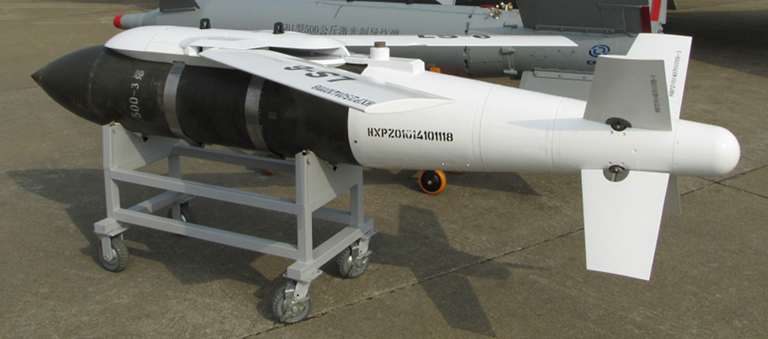 500 kg Luoyang/CASC
LS-6 satellite/inertial guided bomb
at Zhuhai 2010. The LS-6 series of planar wing glidebombs is modelled
on the Australian developed Kerkanya and GBU-31/38 JDAM-ER (Extended
Range) wing kits (Zhenguan Studio, ©
2010 Air Power Australia).
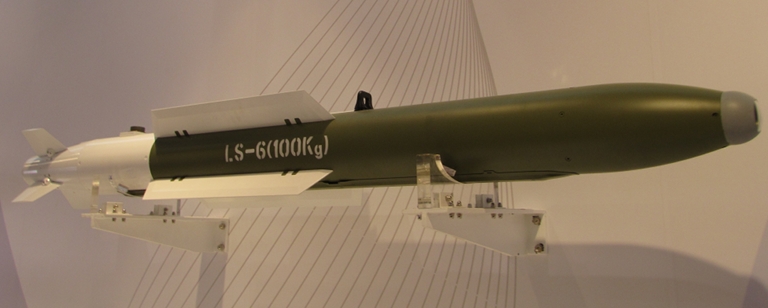 100 kg Luoyang/CASC LS-6
satellite/inertial/electro-optical guided bomb at Zhuhai 2010. This
weapon is a Chinese analogue to the American GBU-39/B and GBU-53/B
Small Diameter Bombs, developed for internal carriage by stealth
fighters (Zhenguan Studio, ©
2010 Air Power Australia).
 Luoyang/CASC FT-2 500 kg satellite/inertial guided glide bomb kit (© 2009, Zhenguan Studio). 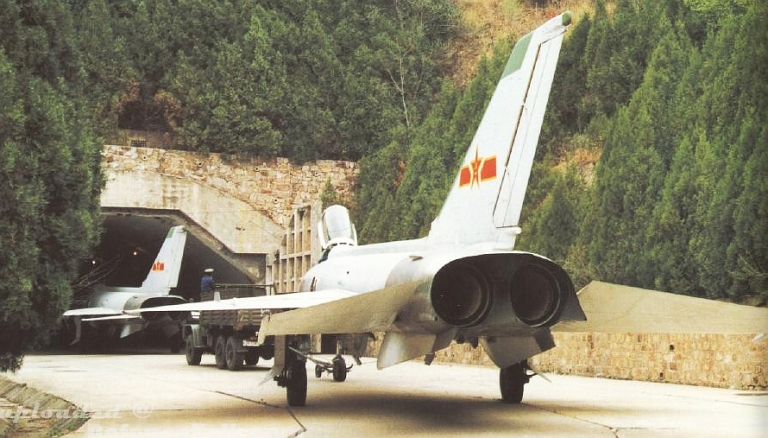 PLA-AF Shenyang J-8 Finback fighters being towed into one of the PLAs many 'superhardened' underground air bases. Tunnelled horizontally into the sides of hills, these bases are unusually difficult to destroy and permit concealed preparations for operation, as fuelling, weapons loading and runup activity is invisible to orbital and airborne ISR assets (Chinese Internet). 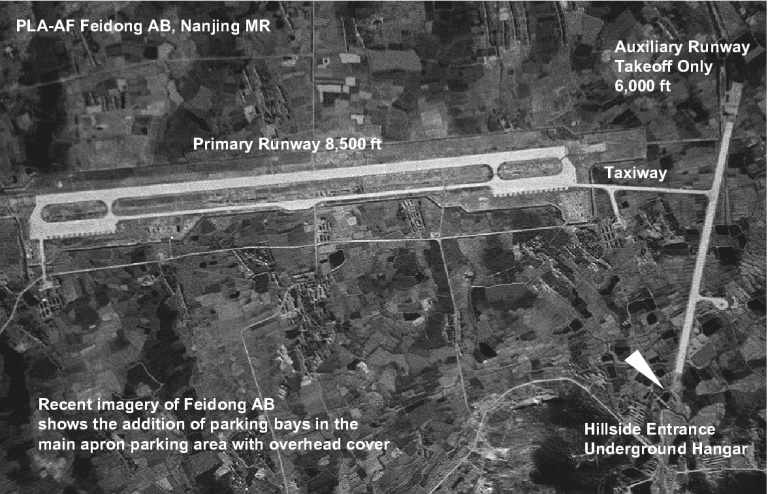 The PLA-AF fighter base at Feidong in the Nanjing MR is a good example of the design of a 'superhardened' fighter base. The primary runway , available for takeoffs and landings, has a wide full length parallel taxiway to enable recoveries in the event of damage. An auxiliary take-off only alert runway is directly connected to the underground hangar entrance, allowing the fighter to roll out of the tunnel, line up, open the throttles and take off without delay. The PLA invested considerable thought into planning its network of 'superhardened' fighter bases, usually placing the runways behind a hill or mountain, relative to the threat axis. Another good example of such a base is at PLANAF Yiwu AB also in the Nanjing MR, which hosts at least seven such bases. While modern smart weapons have diminished the effectiveness of such base designs, they still present genuine challenges in targeting and achieving robust weapons effects (US DoD). 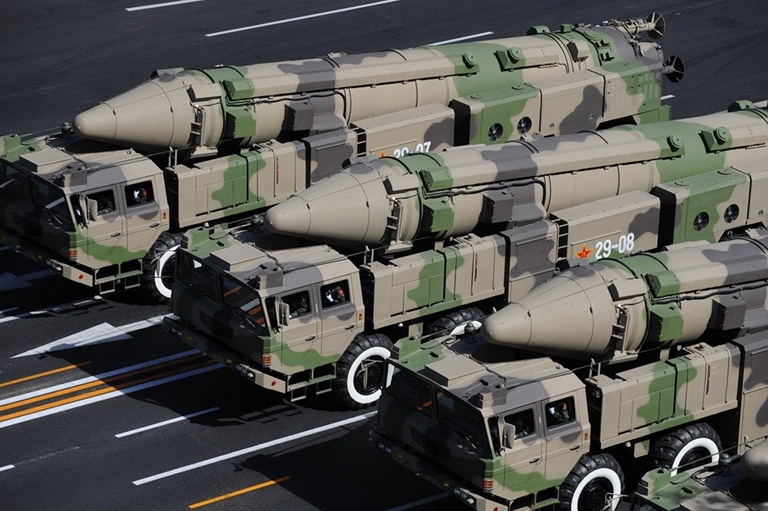 DF-21C
TEL
during
the
2010
parade. DF-21 batteries are dispersed during alerts
making pre-emptive targeting unusually difficult to perform.
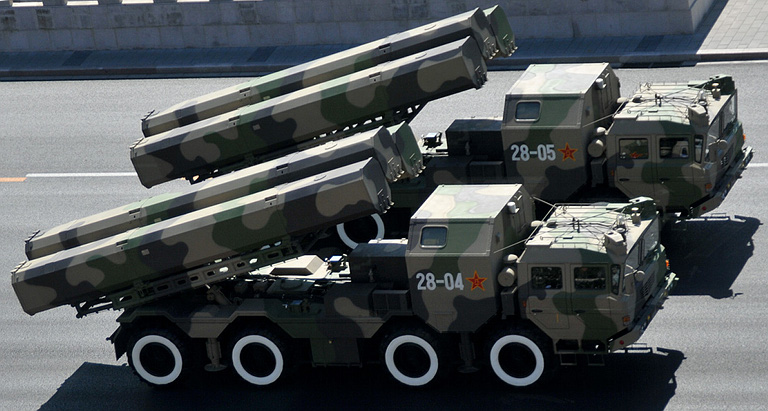 Chinese
sources
report
the
ground
launched
CJ-10
CJ-10
Long
Sword to be the GLCM variant of
the
DH-10 design, carried on a three round TEL. CJ-10 batteries are dispersed during alerts
making pre-emptive targeting unusually difficult to perform
(Chinese Internet).
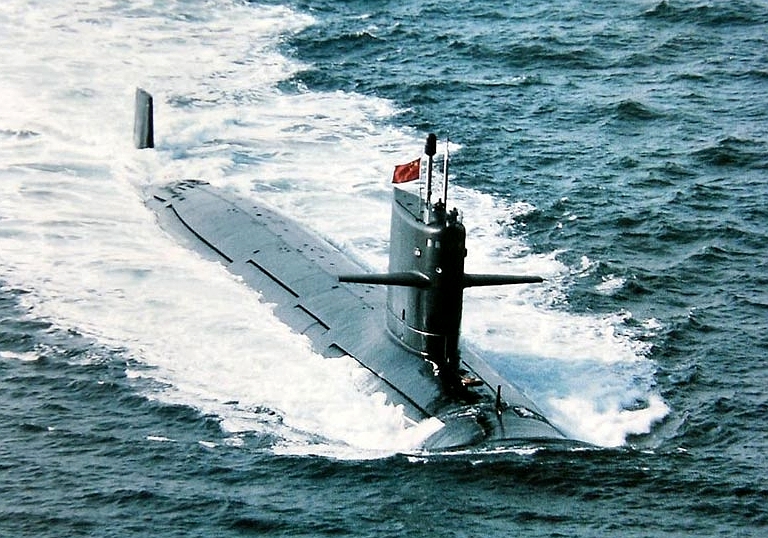 Type
093 or 09-III Shang class SSN of the PLA Navy (Chinese Internet).
 |
|||||||||||||||||||||||||||||||||||||||||||||||||||||||||||||||||||||||||||||||||||||||||||||||||||||||||||||||||||||||||||||||||||||||||||||||||||||||||||||||||||||||||||||||||||||||||||||
|
At
14:00 on the 6th December 2020, the scene moves to Yiwu
Airbase near
Shanghai, a former PLANAF super-hardened underground airbase, and now
the home of the first J-20B Black Eagle Air Regiment. Colonel Liè
Lóng rises to his feet to address his aircrew and battle-staff.
“Warriors, we have been commanded by Air Task Order (ATO) ‘Black Eagle Long March’ to go into battle to liberate the Pacific Ocean from the 75 year tyranny of the United States. Our regiment's task is to eliminate the Guam Air and Naval Bases as viable military installations. We will…..” He is interrupted as each of the men and women rise and begin to cheer – they have been training for this moment for months and years, and have great pride in their expertise and equipment, albeit untested in war. The Colonel raises his hand for silence, and the tumult quickly dies away. “As I was saying, we will fly to the Guam launch points - 50 nautical miles for J-20As and 20 nautical miles for the J-20Bs - release our ordnance, and return. The Intelligence and Weapons Officers have done their jobs well and each bomb has been programmed with a target area. Some of the 100 kg bombs with EO sensors will search for high value targets; other 500 kg bombs will use GPS-INS to destroy fixed installations. We have three squadrons of twelve J-20As and a squadron of twelve J-20B fighter-bombers for the task, so this will be a near-saturation attack.” “J-20B pilots, you will each be flying the ‘Deadly Rain’ manoeuvre you have practiced so many times. Make sure you fly with precision and confidence, as your lives will depend on your skill. The J-20As will also be armed as fighter escorts in case any F-22As or F-35As are on combat air patrol duties. Each aircraft has an individual ATO, so study this carefully. Now, get some rest – we take-off at 06:30, there is a refuelling outbound and possibly inbound if you are intercepted. The mission will last about 7 hours. China salutes your strength and courage.” General Yónggàn de Zhànshì rises at 04:00, dresses and enjoys a hearty traditional breakfast, and attends the final briefing at 05:30. Weather is clear over Guam, as the ‘fanumnangan’ dry season has started – a perfect environment for smart EO bombs looking for an exposed target. At 6:30, he is taxiing as number two in the third element of the second Squadron, and makes an uneventfully smooth takeoff. Captain Gōngjiàn Shou, his Weapon Systems Officer, is nervous flying a combat mission with the Chief, but soon settles into the task. The Squadrons fly out 1,000 nautical miles, and take it in turns to drink from an H-6U Badger or an Il-78 Midas aerial tanker. Then on another 600 nautical miles to the weapons release point. Like all such war activities, this long transit is boring straight and level flight. However, each J-20's radio frequency surveillance system is active, continually ‘sniffing’ the ether for hostile radar and radio transmissions. As they approach Guam, the radars and civil aircraft chatter is intercepted and assessed. Each of the J-20 fighters is part of a ‘Low-Probability-of-Intercept’ information net, with data being exchanged by directional, millimetre wave data-link pencil beams. The network has multiple redundancies and each and every aircraft can act as a peer-to-peer node. As a result, the aircraft all share a common air picture, and the crews can communicate with little chance of the transmissions being intercepted. In the J-20s, a professional calm prevails in each Squadron and Flight as each of the aircraft approaches the GPS release point designated in its ATO. As the J-20Bs approach to 20 nautical miles at 45,000 feet and Mach 1.5, the engines are advanced to full afterburner, and the nose raised to 20 degrees; 0.8G is held. At the designated release point, the weapons bay doors on each aircraft are opened; the LS-6 100 kg smart bombs are ripple-released at one-per-second. Lastly, a single LD-20 decoy dispenser is launched after rolling a few degrees to the right. Doors are closed, the aircraft barrel-roll into a tight Immelman turn to escape, presenting any missiles launched from Guam with a difficult supersonic tail-chase. Engines are returned to military power to close the nozzles and lower the radar signature. Meanwhile, the two hundred and forty released 100 kg LS-6 smart bombs fall into the attack “basket”, descending in a graceful curve. The LD-20 falls 5,000 feet and its three petals open, releasing 49 radar-reflecting decoys, each with aerodynamic drag designed to fall slightly faster than the LS-6 bombs. This, plus the chaff packed throughout the canister, screens the attacking LS-6 bombs and the retreating J-20Bs.
On
Guam at 9:56, it is a beautiful clear Monday. The MIM-104 PAC-4
Patriot teams are recovering from a hectic weekend of social
activities, and are enjoying the light sea breeze. Their reverie is
woken rudely by a blaring klaxon.
Lieutenant
Brown is in charge of the battery, he bounds into the Engagement
Control
Station van.
What
he sees first confounds him, and then horrifies him – 48 radar symbols
bloom across the screen, then from each symbol a cloud expands
with numbers too large to count – all inbound for Guam.
Some
symbols are headed directly for Andersen AFB, others for the Guam
International Airport, and a third set to the Apra Naval Complex. A
gut wrenching comprehension of what is unfolding finally dawns on the
Lieutenant.
“This
is a stealth attack – and those incomings are probably bombs.”
Forty-eight of the symbols disappear as the J-20 weapons bay doors
close, and then a faint, rapidly retreating group of blips appears,
then wink out one-by-one off the screen.
The
larger 500 kg winged LS-6 glide-bombs head for their GPS designated
targets: C3 centres, maintenance facilities, munitions storage and
the massive underground fuel storage tanks.
The
smaller 100 kg LS-6 “small diameter bombs” have a more
interesting task. As they approach their GPS designated search box,
their Electro-Optical seekers scan the tarmac for targets, selecting
high-value planforms like B-2As and F-22As over lesser value targets
like F-35s and F/A-18s. They do not make and lock-in their aim-point
selection until the final few seconds of flight.
Some
240 LS-6s are incoming, screened by no less than 588 ballistically,
and in radar signature appearance, near-identical decoys.
Lieutenant
Brown is not having a good day. He finally orders the battery
“weapons free” to engage as many incomings as possible. His
Patriot launchers have up to 48 ready shots loaded, but with 240
bombs and 588 decoys incoming, his, and the Patriot systems’
tasks,
are impossible. The Patriot missiles scan ahead and each detects and
reports a plethora of returns using its ‘Track-Via-Missile’. Which is a
bomb and which is a decoy? After all rounds are fired,
about 220 LS-6S are inbound, and nothing is left in the Patriot
locker to fire.
Two
B-2As and twelve F-22As are on a deployment to Andersen AFB. They are
just back from the 06:00 ‘sunrise strike’ on Farallon de
Medinilla Island bombing range and are being refuelled, repaired and
re-armed for the next mission at 12:00.
Without hardened shelters, each aircraft is in the open and several
of the LS-6s find them in their designated kill box.
The
LS-6s arrive nearly simultaneously like a deadly hail from Hell, and
the entire tarmac area erupts in a massive series of explosions,
enhanced by aircraft fuel, tankers and weapons sympathetically
exploding. The ground crew watch, horrified, as the LS-6 smart bombs
drop near vertically into the centroid of each aircraft, blasting
them to smithereens. Huge fuel fires and weapon detonations erupt.
At
Guam International, it is much the same. PLA HUMINT has identified
which of the hangars on the north-side of the airfield contain
military aircraft, and several are hit by 500 kg LS-6 glide-bombs.
More importantly, the communications buildings across Guam housing
the trans-pacific fibre-optic cable repeaters are hit with several
bombs, and communications are instantly terminated.
The
Apra Harbour Naval Complex receives multiple hits from the assigned
72 LS-6 500 kg GPS-INS guided bombs. HUMINT delivered by cellular
telephone earlier that morning identifies two nuclear submarines and
three frigates alongside piers. Each receives a direct hit by an
LS-6. The remaining rounds devastate the support facilities.
Ten
minutes later, a pair of J-20R reconnaissance fighters pass over Guam
flying from South-East to North-West, with AESA radars and cameras
recording the damage. Their job is hampered by massive quantities of
burning fuel and aluminium ash in the air, but the AESAs can detect
the detail of shapes on the ground. Post-flight assessments confirm
that all attack objectives were met.
Several
hours later, General Yónggàn
de
Zhànshì
is enjoying the euphoria with the aircrew and support staff in the
Black Eagle Operations Room. “I
cannot, for security reasons, tell you more, but China is very proud
of you, and those who designed and delivered the Black Eagle
capability.”
He
then returns to his J-20B and with Captain Gōngjiàn
Shou,
flies to Beijing International, where the J-20B stealth fighter will
be put on public display. From there, he is whisked away by a staff
car to the Central
Military Commission.
The
Chairman of the Central
Military Commission addresses the assembled members. “Well
done
to each of you and the Services you represent. In Operation ‘Long
March’ the time from first J-20 weapons-bay door opening to the
last DF-21 and DF-10 impact was less than 15 minutes. Twenty
strategic targets were attacked and severely damaged across 6 million
square miles of ocean, and we had no losses. Assessments are still
being conducted, but it seems all strategic objectives have been
achieved. We must now be on our guard for a counter-attack. We are
ready. Thank you all.”
|
|||||||||||||||||||||||||||||||||||||||||||||||||||||||||||||||||||||||||||||||||||||||||||||||||||||||||||||||||||||||||||||||||||||||||||||||||||||||||||||||||||||||||||||||||||||||||||||
|
|||||||||||||||||||||||||||||||||||||||||||||||||||||||||||||||||||||||||||||||||||||||||||||||||||||||||||||||||||||||||||||||||||||||||||||||||||||||||||||||||||||||||||||||||||||||||||||
 |
|||||||||||||||||||||||||||||||||||||||||||||||||||||||||||||||||||||||||||||||||||||||||||||||||||||||||||||||||||||||||||||||||||||||||||||||||||||||||||||||||||||||||||||||||||||||||||||
|
Notes/References/Reading i Kopp C., The Strategic Impact of China's J-XX [J-20] Stealth Fighter, Air Power Australia NOTAM #70, 9th January, 2011, URI: http://www.ausairpower.net/APA-NOTAM-090111-1.html. ii Kopp C. and Goon P.A., Chengdu J-XX [J-20] Stealth Fighter Prototype; A Preliminary Assessment, Technical Report APA-TR-2011-0101, January 2011, URI: http://www.ausairpower.net/APA-J-XX-Prototype.html. iii Stillion J., Orletsky D.T., Airbase Vulnerability to Conventional Cruise-Missile and Ballistic-Missile Attacks; Technology, Scenarios, and U.S. Air Force Responses, Monograph MR-1028, Project Air Force, RAND Corporation, URI: http://www.rand.org/pubs/monograph_reports/MR1028.html. iv Stillion J., Fighting Under Missile Attack, Air Force Magazine, Vol. 92, No. 8, August, 2009, URI: http://www.airforce-magazine.com/MagazineArchive/Pages/2009/August%202009/0809fighting.aspx v Kopp C., EXPANDING THE ENVELOPE - Stealth and Other Strike Roles, Air & Space Power Chronicles, Maxwell AFB, July 2000, URI: http://www.airpower.maxwell.af.mil/airchronicles/cc/kopp.html. vi Kopp C., Maritime Strike Using The F-22A Raptor, Technical Report APA-TR-2007-0401, April, 2007, URI:http://www.ausairpower.net/Raptor-ASuW.html. vii Bolkcom C., Air Force FB-22 Bomber Concept, PDF-A/RS21848, March 21, 2005, Congressional Research Service, URI: http://www.fas.org/sgp/crs/weapons/PDF-A/RS21848.pdf. viii Kopp C., Hardening RAAF Air Base Infrastructure, Air Power Australia Analysis 2008-02, Vol. V APA-2008-02, 5th February, 2008, URI: http://www.ausairpower.net/APA-2008-02.html. ix Kopp C., People's Liberation Army Air Force and Naval Air Arm Air Base Infrastructure, Technical Report APA-TR-2007-0103, 30th January 2007, Updated 2011, URI: http://www.ausairpower.net/APA-PLA-AFBs.html. x LtCol Thomas C. Blake, Jr., Improving the Ground Survivability of In-Theater TACAIR, Air University Review, September-October 1975, URL: http://www.airpower.au.af.mil/airchronicles/aureview/1975/sep-oct/blake.html. xi Kopp C., Andrew M., PLA Guided Bombs, Technical Report APA-TR-2009-0808, August 2009, URI: http://www.ausairpower.net/APA-PLA-GBU.html xii O'Connor, S., PLA Ballistic Missiles, Technical Report APA-TR-2010-0802, August 2010, URI: http://www.ausairpower.net/APA-PLA-Ballistic-Missiles.html; PLA Second Artillery Corps, Technical Report APA-TR-2009-1204, URI: http://www.ausairpower.net/APA-PLA-Second-Artillery-Corps.html. xiii Kopp C., Andrew M., PLA Cruise Missiles / PLA Air - Surface Missiles, Technical Report APA-TR-2009-0803, URI: http://www.ausairpower.net/APA-PLA-Cruise-Missiles.html. xiv Bowie C.J., The Lessons of Salty Demo, Air Force Magazine, Vol.92, No.3, March 2009, URI: http://www.airforce-magazine.com/MagazineArchive/Pages/2009/March%202009/0309salty.aspx xv Kopp C., Assessing Joint Strike Fighter Defence Penetration Capabilities, Air Power Australia Analysis 2009-01, 7th January 2009, URI: http://www.ausairpower.net/APA-2009-01.html and B-2 Variants, GlobalSecurity.org, URI: http://www.globalsecurity.org/wmd/systems/b-2-variants.htm. |
|||||||||||||||||||||||||||||||||||||||||||||||||||||||||||||||||||||||||||||||||||||||||||||||||||||||||||||||||||||||||||||||||||||||||||||||||||||||||||||||||||||||||||||||||||||||||||||

|
|||||||||||||||||||||||||||||||||||||||||||||||||||||||||||||||||||||||||||||||||||||||||||||||||||||||||||||||||||||||||||||||||||||||||||||||||||||||||||||||||||||||||||||||||||||||||||||
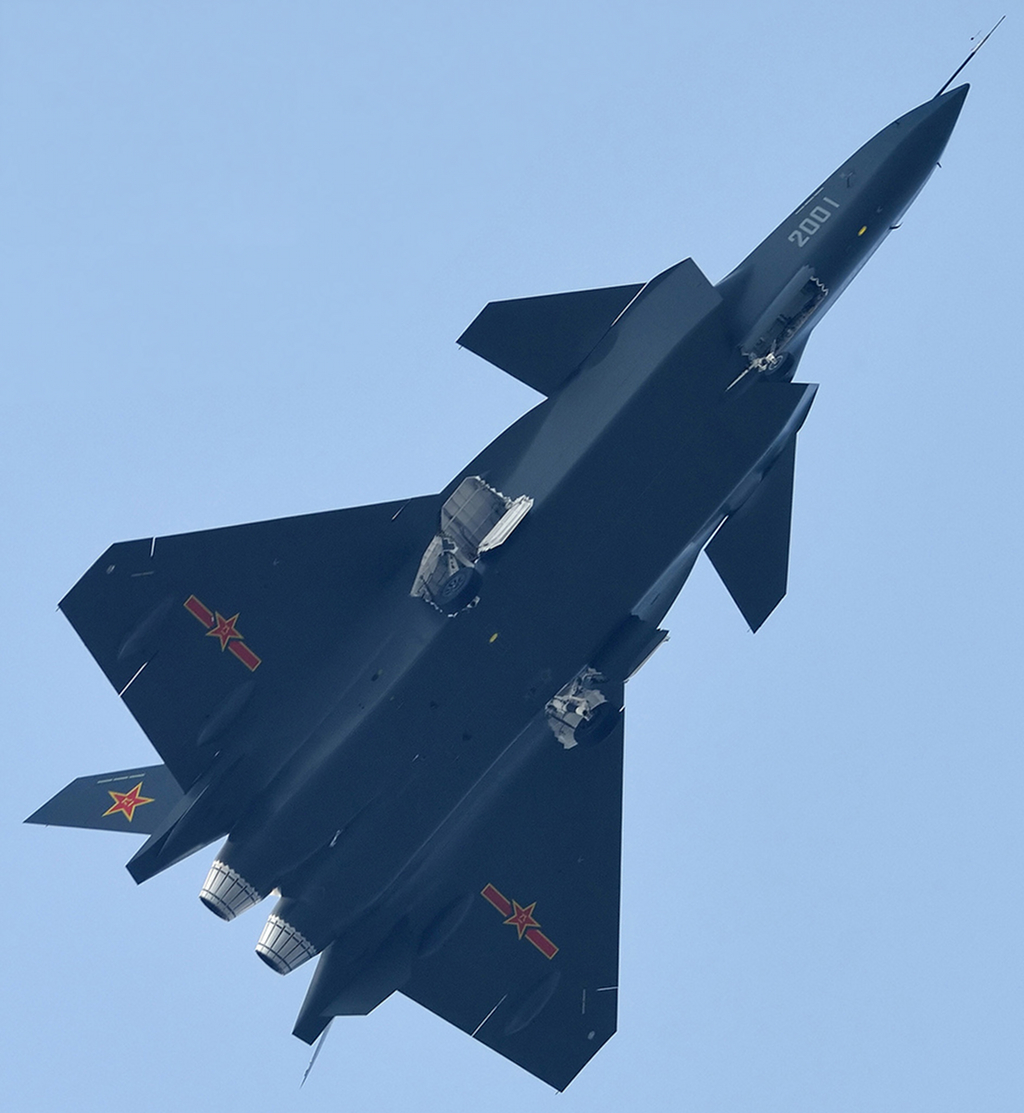 Chengdu J-20 stealth fighter. This
design outperforms the F/A-18E/F and F-35 JSF in every important
respect (Chinese
Internet).
|
|||||||||||||||||||||||||||||||||||||||||||||||||||||||||||||||||||||||||||||||||||||||||||||||||||||||||||||||||||||||||||||||||||||||||||||||||||||||||||||||||||||||||||||||||||||||||||||
|
|
|||||||||||||||||||||||||||||||||||||||||||||||||||||||||||||||||||||||||||||||||||||||||||||||||||||||||||||||||||||||||||||||||||||||||||||||||||||||||||||||||||||||||||||||||||||||||||||
| Air
Power
Australia
Website - http://www.ausairpower.net/ Air Power Australia Research and Analysis - http://www.ausairpower.net/research.html |
|||||||||||||||||||||||||||||||||||||||||||||||||||||||||||||||||||||||||||||||||||||||||||||||||||||||||||||||||||||||||||||||||||||||||||||||||||||||||||||||||||||||||||||||||||||||||||||
 |
|||||||||||||||||||||||||||||||||||||||||||||||||||||||||||||||||||||||||||||||||||||||||||||||||||||||||||||||||||||||||||||||||||||||||||||||||||||||||||||||||||||||||||||||||||||||||||||
| |
|||||||||||||||||||||||||||||||||||||||||||||||||||||||||||||||||||||||||||||||||||||||||||||||||||||||||||||||||||||||||||||||||||||||||||||||||||||||||||||||||||||||||||||||||||||||||||||
|
|||||||||||||
![Sukhoi PAK-FA and Flanker Index Page [Click for more ...]](APA/flanker.png) |
![F-35 Joint Strike Fighter Index Page [Click for more ...]](APA/jsf.png) |
![Weapons Technology Index Page [Click for more ...]](APA/weps.png) |
![News and Media Related Material Index Page [Click for more ...]](APA/media.png) |
||||||||||
![Surface to Air Missile Systems / Integrated Air Defence Systems Index Page [Click for more ...]](APA/sams-iads.png) |
![Ballistic Missiles and Missile Defence Page [Click for more ...]](APA/msls-bmd.png) |
![Air Power and National Military Strategy Index Page [Click for more ...]](APA/strategy.png) |
![Military Aviation Historical Topics Index Page [Click for more ...]](APA/history.png)
|
![Information Warfare / Operations and Electronic Warfare Index Page [Click for more ...]](APA/iw.png) |
![Systems and Basic Technology Index Page [Click for more ...]](APA/technology.png) |
![Related Links Index Page [Click for more ...]](APA/links.png) |
|||||||
![Homepage of Australia's First Online Journal Covering Air Power Issues (ISSN 1832-2433) [Click for more ...]](APA/apa-analyses.png) |
|||||||||||||
| Artwork, graphic design, layout and text © 2004 - 2014 Carlo Kopp; Text © 2004 - 2014 Peter Goon; All rights reserved. Recommended browsers. Contact webmaster. Site navigation hints. Current hot topics. | |||||||||||||
|
Site Update
Status:
$Revision: 1.753 $
Site History: Notices
and
Updates / NLA Pandora Archive
|
|||||||||||||
|
|
Tweet | Follow @APA_Updates | |||||||||||
|
|
|||||||||||||
|
|
|||||||||||||